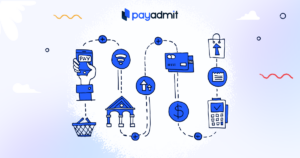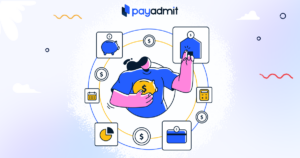Massive digitalization has a direct impact on the payment processing industry. The number of online transactions reached 1.3 trillion in 2023. The transaction value is projected to show an annual growth rate of 9.5% leading to a total of $16.6 trillion by 2028. The changing market habits and other metrics surely contribute to this uprising trend. Thus, businesses have to integrate new financial strategies to keep their online consumers satisfied. In our overview of the payments industry, we will take a closer look at the evolution of electronic transactions, the concept of payment processing, and key players.
The payment processing ecosystem is a dynamic network of players, enabling smooth digital transactions. Issuers and acquirers all take a significant place in the payment process. They have the power to customize their operations, enhance security measures, and provide a personalized payment experience. Understanding the ecosystem is important for businesses and consumers alike. This knowledge can influence the efficiency and security of digital transactions.

The key players help businesses and consumers exchange money for products and services. Understanding how each of them works allows commercial companies to make strategic decisions and optimize their payment processes. Here is an overview of what key players do within the payments industry landscape:
Customers are individuals or companies that use payment services to purchase stuff or transfer money. For example, cardholders are paying with debit and credit cards. They turn out to be the end-users who initiate the financial operation with the commercial company. Within this value chain, they get an opportunity to pay for products and services online and in person.
Businesses open a corporate account to accept payments. They usually buy this service from the acquiring bank. To provide customers with a fast and easy buying experience, they can support several payment methods. For example, they can receive payments made at a virtual point-of-sale (POS) terminal or in a digital wallet in real time.
Payment networks enable digital transactions between various parties in the ecosystem of global payments industry. They create the special framework for processing payments. The most common options include Visa, Mastercard, and American Express. Each of them acts as the platform for making card transactions possible. In other words, it transfers funds from the acquirer to the issuer and charges a special fee for its service.
Issuers or issuing banks are financial organizations that deliver debit and credit cards. They are responsible for managing payments verification. When they receive the financial details from the acquiring bank, they check everything and approve or decline a transaction. They make payments on behalf of their consumers.
For approvals, issuers must ensure the accuracy of financial details, the availability of sufficient funds, and the cardholder’s real identity. If all goes well, issuers will send a response code to the acquiring bank. For example, Diamond Bank create cards (both credit and debit) for customers. It also tends to manage the potential credit card risks.
Acquirers or acquiring banks are financial institutions that collaborate with businesses to handle card payments. They enable the acceptance of electronic payments by opening and maintaining corporate accounts, managing transactions, and transferring funds from personal to corporate accounts. To be specific, they receive the transaction details and transfer those to the customer’s issuing bank for approval. This usually takes place through an independent processor. Acquirers make payments on behalf of a commercial company.
After receiving the payment, the acquirer transfers money to the merchant account within 2-3 business days. The amount excludes different types of fees (e.g., interchange fees).
Payment processors, also known as credit card processors, are companies that create business accounts, manage card operations, and integrate anti-fraud measures. They are often associated with acquiring banks like Bank of America, or they can be independent organizations like Fiserv. Payment processors are obliged to go through special training and obtain a certification that would prove their competence.
Payment processors manage the tech side of transactions between issuers, acquirers, and businesses. They help businesses accept different forms of electronic payments, including bank cards and mobile wallets. When payment processors receive the transaction details, they send those to the well-reputed network (Visa, Mastercard, American Express, etc.) for approval or decline.
Payment gateways are software applications that help companies accept payments and send financial data for processing. They create a technical layer that takes control of the customer’s data during the transfer period. The payment details collected on the customer’s side are passed on to the acquirer.
Hydrogen is a good example of a payment gateway that transmits financial data between businesses, payment processors, and acquirers during the transfer period. It also provides other assessable value-added services, including fraud management and smart routing.
Merchant services providers enable businesses to accept and process electronic payments by managing the hardware and software required for transactions. They act as intermediaries between businesses and acquiring banks, facilitating the money transfer between customers and businesses. MSPs offer additional services, such as fraud protection and POS systems, to ensure secure and efficient transactions.
Independent Sales Organizations and Payment Facilitators are some of the most common MSPs to name a few in the payment processing industry. By offering customized payment processing tools, they help businesses speed up operations across various channels.
Independent Sales Organizations are independent sales companies that happen to be intermediaries between businesses and acquiring banks. They take responsibility for selling corporate accounts and processing electronic transactions on behalf of acquirers and payment processors. They usually don’t have a financial institution or an acquiring license behind their back. ISOs offer their services through the network of sales agents or resellers. Regulated by payment networks like Visa and Mastercard, they always comply with certain standards to maintain their reputation.
Payment facilitators are companies that help businesses accept electronic transactions without establishing a direct contact with an acquirer or a corporate account. They bring various businesses under a single corporate account in order to simplify the onboarding process and minimize expenses. They manage different aspects of payment processing, including authorization, settlement, and fraud management.
Due to the consolidation trend, PayFacs makes it possible for Independent Software Vendors (ISVs) and Software-as-a-Service (SaaS) providers to handle payments within their software. Thus, they receive control over the customer experience and gain a portion of processing fees. More and more integrated payment solution providers have implemented the PayFac-as-a-Service (PFaaS) format and enjoy a better user experience, revenue sharing, and lower financial risk.
Regulatory bodies and government agencies ensure the integrity, safety, and effective functionality of the payment industry vertical. Organizations such as the Financial Conduct Authority (FCA) in the UK, the Virginia Bankers Association (USA), and the Economic and Financial Crimes Commission (EFCC) in Nigeria regulate financial operations, minimizing the risk of fraud and ensuring compliance with legal standards.
These institutions enable the dynamic growth of the payment sector by adapting to technological advancements (e.g., data analytics, cloud computing, and artificial intelligence), evolving customer needs, and regulatory changes. Their presence encourages the development of new payment methods and the maintenance of consumer safety in the financial ecosystem.

The payment processing cycle has a complex structure based on moving parts. When a customer swipes their bank card at a payment terminal, the transaction usually takes only a couple of seconds. The process itself goes through two phases (authorization and settlement). Let’s get started!
The customer payment information needs to be verified. Is there any problem found? If no, the transaction will be approved for further processing. Here’s an overview of the key steps:
Customer uses the card: The customer swipes the card at the POS terminal.
Data transmission: The card details and transaction amount are sent to the company’s payment processor.
Forwarding to acquiring bank: The payment processor passes the information to the acquiring bank.
Forwarding to card network: The acquiring bank passes the information to the customer’s credit card network (e.g., Visa, Mastercard), which forwards it to the issuing bank.
Issuing bank verification: The issuing bank verifies funds, and then approves or declines the transaction.
Authorization code: If approved, the issuing bank assigns an authorization code. Then, the funds are placed on hold.
Response transmission: The approval is sent back through the credit card network, payment processor, and acquiring bank to the company’s terminal.
Completion: Once the process is completed, the customer gets a printed receipt.
The settlement process occurs at the end of each business day, when the company closes out daily transactions and initiates the transfer of funds. Here’s an overview of the key steps:
Closing out sales: The company closes out the day’s sales and transmits the information to the payment processor.
Information transmission: The payment processor sends the transaction data to the acquiring bank.
Forwarding to card network: The acquiring bank passes the transaction information to the credit card network for settlement.
Forwarding to issuing bank: The credit card network passes the approved transactions to the customer’s issuing bank.
Funds transfer: The issuing bank transfers the funds to the company’s acquiring bank, while taking the interchange fee.
Funds depositing: The acquiring bank deposits the remaining funds into the company’s account, while taking the merchant discount fee.
Cardholder billing: The issuing bank bills the cardholder for the transaction.

With the payments industry explained in the previous sections, you should learn how to make your business operate smoothly within this ecosystem. Consider the following aspects:
Business needs and goals. Identify your business needs based on your target audience, distribution channels, transaction value, and expected revenue. Make a list of strategic goals, such as possible expansion into new markets.
Variety of payment methods. Select the most relevant payment methods (e.g., credit cards, debit cards, mobile wallets, bank transfers) for your business. Integrate foreign currencies to accept cross-border payments.
Business services provider. Choose a business service provider that supports a wide range of payment options. Make sure your customer can pay for products and services with ease.
Customization and integration. Use APIs and other tools to integrate the selected payment solutions into your website, application for mobile devices, or POS system.
High security. Ensure your provider prioritizes security to protect customer data. With business insurance, it can be possible to further reduce the risks of fraudulent transactions.
Scalability and adaptability: Choose a provider that can grow with your business, offering services like subscription management and marketplace payments.
Reporting and analytics. Look for comprehensive analytics and reporting features. Use these features to monitor payment history, identify current trends, and make data-driven decisions for optimizing your strategy.
Customer care. Ensure the provider offers responsive and reliable customer support for explaining the terms and addressing the issues related to payments processing.
Regulatory compliance. Select a provider that complies with state regulations like PCI DSS and GDPR. This will help you meet regulatory requirements.
Financial analysis. Compare pricing and fee structures to choose a provider that fits your budget and transaction volume.
Different types of electronic transactions have become a common thing in many spheres, including fintech, ecommerce, and even construction. When your business decides to integrate electronic payments, make sure to do some research and analysis of the possible challenges. Check various sources and market statistics to meet the evolving needs and preferences of your consumers.
The digital disruption in both B2C (business-to-consumer) and B2B (business-to-business) payments will continue in 2024 and beyond. The recent rise of digital wallets, crypto exchanges, and evolving customer expectations are driving further transformation in the payment industry. The growing competition among payment providers enables more transparent pricing models, discounts for high-volume transactions, and customized packages. The more you learn about the payments industry, the better experience you will be able to provide to your customers.